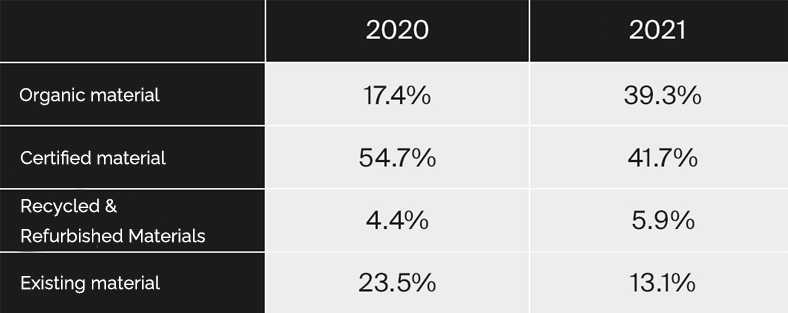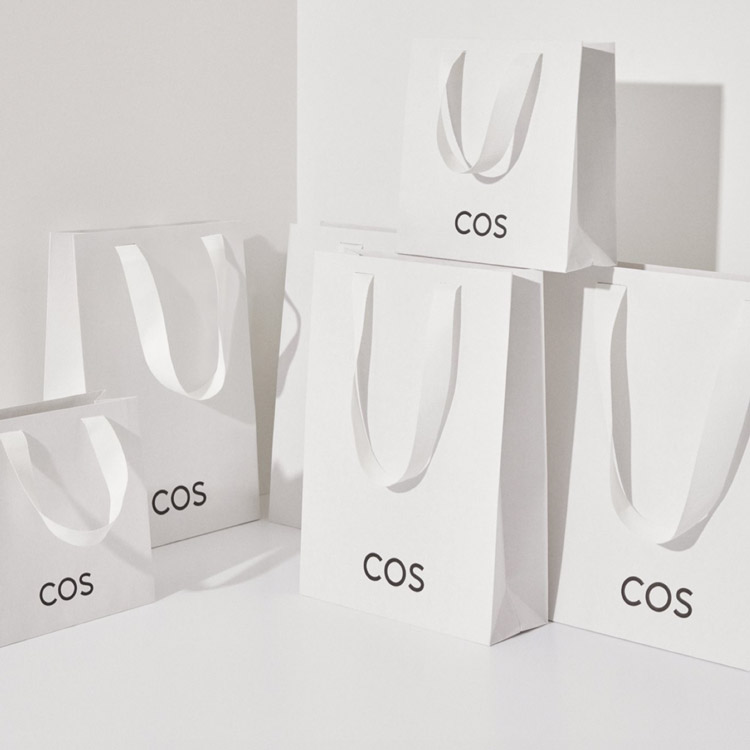Shopping Cart
-

Leather Phone Pouch
- Size
- no size
- Color
- black
- Order
- one
- Quantity
- 79,000
- Total Product amount
- 79,000
- Shipping Fee
- 0
- TOTAL AMOUNT DUE
- 79,000
Your cart is empty

Your cart is empty
Better looks beyond
COS pursues a more sustainable future regardless of season or trend.
We work with local communities, supply chains and partners to create collections using innovative materials.
Check out our overall course on sustainability.

In 2020, 76% of the collection's materials were produced in a sustainable way. By 2021, we have switched 86% to sustainable materials. Our goal is to achieve a transition to 100% recyclable and sustainable materials and become an environmentally friendly brand.
From the beginning of the brand, our design philosophy has been to pursue quality
and sustainable quality. We believe that our choices, our clothes and our lives
can do more for less.
We are committed to finding quality, environmentally friendly materials.
It's not just the fabric or decoration that makes a product sustainable,
but working in an environmentally friendly way also plays an important role in making
a product sustainable. At COS, this is called environmental responsibility.
Sustainability is not just about minimizing our impact on the environment.
As a company, we set ethical standards and focus on our commitment to the people and
communities who make our products. We call this social responsibility, and we believe the
strong relationships we have built with our suppliers around the world are paramount to
meeting our goals and standards.

Organic Materials
The organic materials used by COS are grown from organic seeds that have not
undergone any genetic modification. Because no chemicals or synthetic fertilizers are
used in the cultivation process, it is beneficial to both the global environment and
humankind. We are also exploring new technologies and production methods.
For example, growing organic crops in a renewable way. As a result,
maintaining healthy soils helps combat climate change and water scarcity.
2020: 17.4% of all products used organic materials
2021: 39.3% of all products used organic materials so far

Responsibility
COS deals with certified materials in three categories.
Environment, animal welfare and social responsibility. Working with an independent
certification program, we provide our customers with materials that are traceable and
ethically crafted.
2020: 50.8% of certified materials used in all materials
2021: 35.2% of certified materials used in all materials so far, expected to exceed
last year’s figure by the end of 2021

Recycled & Refurbished Materials
Recycled cotton, wool, polyester and nylon materials use fewer chemicals,
reducing demand for limited natural resources. We also collect discarded and leftover
materials to design refurbished items in our collections in cotton, wool and cashmere.
Because of the complexity of the refurbishment process, there aren't many brands that
can do it at the scale we're working on.
There's a lot more could be done, but I'm proud that COS is leading the way.
Through new production processes and innovative methods, we will increase
the proportion of recycled materials and maintain high-quality materials.
We aim to produce 30% of recycled materials by 2025.
2020: Ratio of recycled and refurbished materials among all materials 4.3%
2021: 5.8% so far

Existing materials
We make products that can be with us for a long time. We also use conventional
materials such as leather or silk to meet the high quality we seek. Meanwhile,
we strive to find better alternative materials and help the material industry develop.
We have replaced a lot of synthetic materials with recycled materials,
and we are also replacing silk with organic silk. By fall 2021, all leather goods are aiming
to be made with a cleaner tanning method without the use of metallic chrome.
2020: 17.1% of the total materials are conventional materials
2021: 19.6% of the total materials are conventional materials.
We want to further reduce this ratio.

STATISTICAL DATA
Check the table below to see the difference between the percentage of materials used
last year and the percentage of materials used until 2021.

Packaging
We are redesigning our packaging to use more sustainable and fully recyclable
aterials. Our first goal is to reduce material usage. We've already significantly
reduced the amount of COS packages our customers receive when they place an order.
We aim to reduce the amount of plastic packaging we use to protect clothing during
shipping, and we are increasing the proportion of packaging that is reusable,
recyclable and environmentally friendly. In the distribution process,
we attempted to replace plastic bags with reusable cloth bags. As a result,
this plan has been implemented on a larger scale.
We aim to reach 100% reusable, recyclable or compostable packaging by 2025.
Our Sustainably Produced Textiles and Materials collection has all kinds of sustainably produced materials, highlighting this to help customers make more thoughtful shopping decisions.
We also always try to find new and innovative production methods to reduce our environmental impact.
To qualify as a 'sustainable material', a product must be made from at least 50% sustainable materials. Some of our products contain more than 50%! With the exception of recycled and refurbished materials, the overall quality of materials meets our standards.
Our work is part of a broader vision. COS, together with the H&M Group, is working towards a holistic circulation of resources. Check out the journey we are taking.
Refurbished Cotton is a new yarn made from our scrap fabric, which can reduce land, water and energy usage. This yarn is mixed with longer fibers to create a more durable yarn. Breathing new life into scrap fabric like this is one of our most pioneering attempts.
Yak wool is made from the hair of a yak that grows in the Himalayan pastures. A material that can be identified and traced to its supply path and produce in a sustainable manner.
The wool fibers we use are of the highest quality, which also means that good fibers can be turned into new fabrics. It is more difficult to guarantee the quality of the fabric if you reuse low-quality fibers in the first place. That's why not many brands reuse wool on a scale as large as COS.
Shattered glass undergoes repeated heating, cooling and shaping to be reborn as sculptural pieces of jewelry in various shapes.
Refurbished Cashmere is made from surplus left over from the manufacturing process. In this way, the impact on the environment can be minimized and precious resources can be fully used. Due to the complexity of the process, it is not uncommon to reuse cashmere. We are proud to be at the forefront of transforming these production chains.
Recycled down used for outerwear and accessories is an eco-friendly thermal insulation material that is manufactured in an environmentally friendly way. It has excellent thermal insulation properties and is often used for padded jackets and bedding. It is recycled through a disinfection process with solar energy and recycled water.
Using recycled nylon can reduce demand for limited resources. It uses less energy and chemicals and produces less carbon dioxide than conventional nylon. Various waste materials, such as fishing nets, can also be turned into new clothes.
The Ethical Down Certification Body is an organization that strives to ensure that animal welfare is observed in the manufacturing of down products worldwide. We manufacture padding and accessory products from down materials that have undergone ethical down certification.
The recycled polyester in the COS collection is made from production waste generated during consumption. This is a much better way than making new polyester from crude oil. Crude oil is non-renewable and is increasingly being depleted. Recycled polyester can also be reused over and over again.
Made of soft and flexible material, it is characterized by a comfortable fit. The cashmere left over from the production process can be used to add new value to the product. It is sometimes blended with other fibers to maintain superior quality.
TENCEL™ is the only lyocell fiber brand known to be sustainable. This natural material is crafted from forest eucalyptus trees that are FSC-certified, demonstrating responsible forest management for ecosystem conservation. The tree is made in a circular production process, reusing 99% of all chemicals and water instead of releasing it into nature. The result is a beautiful material that is soft to the touch, airy, washable and wraps around the body.
To understand the cashmere supply route and to protect animals and the producer community, we manufacture products using materials that comply with the Good Cashmere Standard.
Although unfamiliar, cupra is a plant material with surprising properties. It is made from a soft fiber from a plant we often throw away, called cotton linter. Made from 100% natural materials, not only recyclable, but also biodegradable, with a soft, silky feel and as breathable as cotton.
It is a fiber made from raw materials extracted from beech trees through an eco-friendly production process. It is a soft yet sturdy material.
Organic cotton is now a familiar material. Made from organic seeds that have not undergone any genetic modification. It is a very important feature that no chemicals or synthetic fertilizers are used in the growing process, and the soil is not polluted.
It is an eco-friendly material that has been used for thousands of years. COS uses fibers derived from hemp seeds that are free from genetically modified ingredients or harmful to the environment.
Every product in the COS Recycled Silver collection has a story behind it. Sterling Silver earrings, necklaces and rings are made from recycled objects, from coins, silverware and even old jewelry. It has been reborn with a new design with a modern sensibility.
It is a material that does not lose its unique properties even when recycled. COS uses recycled brass that has passed the Global Recycle Standard (GRS) and Recycled Claim Standard (RCS) certifications to produce accessory products featuring a sculptural design.
It complies with the Responsible Wool Standard (RWS) and is produced in an ethical way with the welfare of animals and the producer community in mind. RWS wool is a soft, breathable, biodegradable, eco-friendly material.
The fabric left over from the production process or display stands, optical lenses, water bottles, and industrial products discarded during consumption are melted and reborn as a new type of jewelry.
 Sustainability Team Director Francesca Lilley
Sustainability Team Director Francesca Lilley
Social Responsibility “Just like making a product using good materials, it should be able to make a positive difference to society throughout the lifecycle of a product.”
Our mission is to be a transparent and responsible brand in all areas of our business, not just material production. We want everyone we work with, globally and locally, to experience a safe, fair and equitable work environment.
After launching the brand, we have built a win-win relationship with suppliers and partners. They are part of the COS family like us, and they share our corporate values of quality, sustainability and innovation. We have been working with the same partners since 2007. There are many partners, from denim experts in Turkey to cotton growers in India to manufacturers in Portugal, Romania and China. Working with various partners, such as small-scale suppliers who excel in traditional technologies or large-scale factories that focus on new technologies, we have developed great expertise and passion, and we are moving towards the future while going through adversity together. We look forward to more collaborations to become a brand that represents more sustainability. Learn more about the